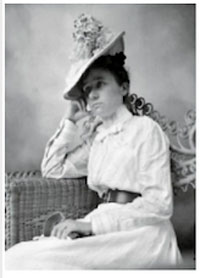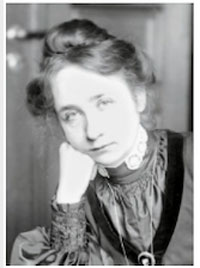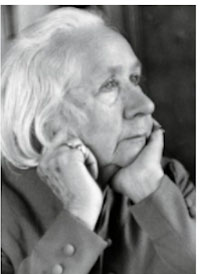|
The more dramatic a
relationship, the
greater the temptation
to write about
it—even novels,
which sometimes falsify
more than they reveal.
Gabriele M√ľnter
(1877-1962),
Kandinsky's student
and life partner until
1914 is now finally
recognized as a
remarkable painter.
During the work on my
new edition of Kandinsky's letters,
I found some rare
documents on M√ľnter as
well. So I'd like
to share a more
positive picture of her
than Kandinsky's
letters do.
While his letters have
survived quite well
(about 1000 handwritten
pages), not many of
M√ľnter's have.
Their correspondence
shows that they lived
together mainly when
travelling. And that
from 1909 on, after the
purchase of a country
house in Murnau, they
most often took turns:
one stayed in Munich,
the other one in
Murnau.
The most difficult
episode of their life
together is well known:
the months they spent
in Paris/Sèvres in
1907. It has also been
widely noted that
Kandinsky did not
fulfill his promise to
marry M√ľnter. They met
for the last time in
Stockholm in 1915,
where they became
friends with
psychiatrist Dr. Poul
Bjerre—and this,
too, has been
documented (by Vivian
Barnett: Kandinsky and Sweden,
Malmö 1989). But
beyond what is already
known, there exists a
late, revealing letter,
of four handwritten
pages, by M√ľnter.
*

Gabriele M√ľnter in Marshall, Texas, USA, 1899–1900.
© Gabriele M√ľnter and Johannes Eichner Foundation, Munich.

Gabriele M√ľnter, Dresden 1905, photograph: Wassily Kandinsky.
© Gabriele M√ľnter and Johannes Eichner Foundation, Munich.

Gabriele M√ľnter, 1952, photograph, photographer: Sigrid B√ľhring
© Schlossmuseum Murnau, picture archive.
Murnau, April 7, 1949
Dear Dr. Bjerre!
{...} We have not heard from each other for so many years. So allow me to
send you a sign of life.
If I think about it now, I made a big mistake to lose contact with you
during the last part of my stay in Sweden; and then just to leave quietly.
You certainly know my reason: that Kandinsky, when leaving Sweden,
had not come back to me, as he had promised. I was quite upset about the
end of our 13-year cohabitation; it at least merited an honorable
resolution. — Perhaps your professional knowledge and perspicacity
would have helped us to grasp and clear out the complications of our
lives. The breakup, and the way it was done, were difficult for me to bear
and to understand. I then withdrew into myself and suffered loneliness for
a long time. Also my artistic work wilted. It took me years to recover. In
1920, I finally decided to leave Scandinavia (I had been in Denmark since
1917) and to go back to Germany. — My memories of K. are divided
between my admiration for him as a great artist and the disappointment
about the manner of his escape from our engagement; he had said, until
the very end, that it was stronger than any legal formality. — Only since
1931, after a long, aimless, wandering life, have I returned to the small
rural house in Murnau, which I had bought at Kandinsky's wish "for our
old age." Since then my life and my artistic work have become firm and
meaningful again. Here I spent the period of dictatorship, with some
danger and difficulty. From the war I was spared. So I am living and
working in my home, in good health and with no disturbance. The
philosopher and art critic, Dr. Johannes Eichner, whom I have known for
more than 20 years, lives here with me and helps me with my affairs.
Right now, a traveling exhibition is being prepared, which will give an
overview of my whole life's work. It should already have taken place 2
years ago for my 70th birthday.
Now, after the destructive art politics of the dictatorship, the
interest in modern art is increasing again, and one looks back to the
beginnings, in which I, too, took part. A large, historic exhibition was
planned in the municipal gallery in Munich for the "New Artists'
Association" and the "Blue Rider"; I would have played an important
part, having shown 14 paintings between 1908 and 1914. But, to my regret
, financial difficulties and other obstacles were in the way. I would have
been included in such a very important show, which was supposed to go
on to other places, as well as to foreign countries. — I'm enclosing a small
souvenir of the founding of our Association in 1909.
Our time is now devoted to memories. I am sorting old letters,
which bring the old times to life in my mind. Many old relationships are
lost, many questions come up. What could have happened to Lucie and
Erich Gutkind (Volker), by whose mediation I found my way to you? I
hope very much that they were able to flee in time from the catastrophe in
Germany! I also found letters from Mitrinovich, whose World-Union
-League (Weltliga) won you over, too, through Gutkind. How different the
world would look if spiritual people, reason and kindness had been
leaders of the people! As we learned in Sweden, Mitrinovich had luckily
found a safe haven in England in 1914. After that I did not hear from him
anymore.
I would be happy to learn through you about our good old friends
and especially about yourself, you lucky one.
With cordial greetings,
Gabriele M√ľnter
*
We see here that M√ľnter was aware her work had flagged for many years.
In Sweden this was not yet the case; Kandinsky had remarked in May of
1916: Your pictures have turned more serious, deeper, steadier. I find
more individuality and a very personal trait in them, and this will make
you immortal.
The last part of her late letter is especially revealing, where she asks about
their common friends, Gutkind and Mitrinovich, the founders of a utopian
society, involving other idealistic notables, to create a new, peaceful
Europe. Well, this was in 1914, shortly before WWI annihilated their well
-meaning projects. There is plenty of literature, mainly about the Serbian
Mitrinovich, where Neville Chamberlain is mentioned as a potential
member. But Gutkind, in a hardly known letter of July 12, 1914 to
Mitrinovich, spoke of his hesitations about the British politician: I cannot
find that his point of view is "all-European." He rejects, in an almost
violent way, the Jewish as well as the Roman Europe, which are in fact
absolutely indispensable factors.
It is good to hear such a voice from Berlin. The same is true of M√ľnter's
statement against the Nazi dictatorship; after all, one was astonished by her
participation with two small pictures in 1936 in the traveling exhibitions,
"Adolf Hitler's Streets in Art." But the initiative for her participation came
more from her friend, Johannes Eichner, than from her. He was the only
one besides Kandinsky who tried to influence the style of her art.
Fortunately she only listened for a short time to Eichner's suggestions. Still
in May of 1955, he asked Bjerre to send him photos of one of Kandinsky's
rare figurative watercolors of 1916, a gift of the artist. He also mentioned
then that M√ľnter had painted 100 pictures in one year, proof of her
regained creativity.
*
More M√ľnter Resources
Brief video (1:32) on Gabriele M√ľnter. With fantastic photos! (In French)
https://twitter.com/ARTEfr/status/1693518300582756682
Informative article on M√ľnter, with lesser known photos of her and her
work.
https://www.tretyakovgallerymagazine.com/articles/1-2022-74/gabriele
-munter-not-just-lady-painter-dozen
|